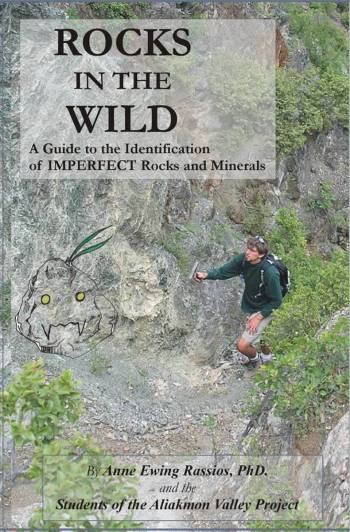Rocks in the Wild, A Review
Rocks in the Wild by Anne Rassios, PhD and the students of the Aliakmon Valley Legacy Project
Rocks in the Wild
ISBN 978-960-87453-3-9
Published by The Institute of Geology and Mineral Exploration (I.G.M.E.) for the Aliakmon River Legacy Project. http//www.igme.gr/enmain.htm. Contact RassAnnie@gmail.com to order a copy. $17 includes shipping.

I am not a rock hound. I just like finding a pretty stone on my walks with my Jack Russell Terrier, Barnie. I can recognize the milky white quartz that abounds on the farm, and I know the granite in the driveway came from local quarries. I think my favorites are the river stones, worn smooth by the eons of time. Once I found a quartz crystal, exposed by the previous night's rain that cut a gully in the tractor path to the back pasture. I brought it home and washed it, measured it, and peered at it with a magnifier. Inside the crystal are tiny, mini crystals. It is tucked away in a drawer now.
Rocks in the Wild by Anne Rassios, PhD and the students of the Aliakmon Valley Legacy Project (that is in Greece, for those who don't know) is just the sort of book for someone like me, and for real rock hounds as well.
Anne Ewing Rassios traveled to Greece to do research for her doctorate. She accomplished that goal and went back to Greece to work at the Institute of Geology and Mineral Exploration, where she has been for over 25 years.
This book about rocks is funny! Who would think there is humor in rocks? But, it is Rassios' love of her work and her desire to share it with others that comes through in her writing, photography and the cartoon sketches sprinkled on the pages of Rocks in the Wild. To get an idea of her humor turn to the last page of he book (you're going to do that anyway, so now you have my permission) and read her disclaimer, " NO ROCK has been abused or injured in the making of this books, though several have been sliced in half."
She teaches us that visual assessment of a rock is 80% of the identification process. "Rocks are innocuous in the wild, sly but subtle, enigmatic but harmless, they do not bite. The scorpions clinging to their backsides as you pick them up DO bite, so be careful." I love those practical tidbits, and you'll find them throughout the book. Rassios goes on in the book to teach us how to visually identify rocks in the wild.
Rocks in the Wild gives the reader many tips on identifying rocks and minerals in the field. At the suggestion of one of her students, Rassios shows pictures of rocks as they look in the rough, rather than the immaculate specimens one finds in museums and books. She discusses the tools one needs to collect specimens, how rocks are formed, and expounds upon a list of rocks and rock types. She tells us they are common and worthless rocks. They are rocks that you are likely to pick up and feel, and then toss back onto the ground or riverbed from where you found it - or perhaps not.
Perhaps after reading Rocks in the Wild you will want to start a rock collection, maybe become a real rock hound, maybe a geologist. I am sure Dr. Anne Ewing Rassios would be delighted if her book inspired a future scientist in her field. I believe this is a book that should be in all school libraries and in the personal library of anyone with an ounce of curiosity about rocks.
Note: The studies of these rocks are being made before the construction of a new hydroelectric dam, after which the area will be flooded. The book was funded by The Public Power Corporation of Greece. http://www.dei.gr/



